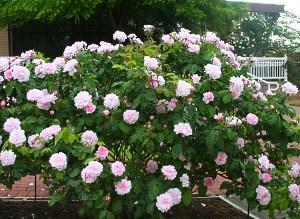Canadian roses - undemanding garden beauties
 Canadian roses are considered to be an unpretentious decoration for parks and gardens. It is Canadian roses that are advised to grow to novice flower growers. The main advantages of the "Canadians" include high frost resistance, the ability to quickly restore the bush after freezing and increased resistance to "Pink" diseases - black spot and powdery mildew.
Canadian roses are considered to be an unpretentious decoration for parks and gardens. It is Canadian roses that are advised to grow to novice flower growers. The main advantages of the "Canadians" include high frost resistance, the ability to quickly restore the bush after freezing and increased resistance to "Pink" diseases - black spot and powdery mildew.
All varieties of Canadian selection are divided into two groups, depending on the location of the creator laboratory:
- Parkland Rose (Parkland) - erect bushes with exquisite flowers of various colors.
- Explorer Rose (Explorer) - branched and climbing bushes with fragrant flowers of a simpler shape.
For our compatriots, the Canadian rose is interesting for the possibility of growing in the northern regions, where the winter temperature drops to -30aboutFROM.
Read also about beautiful peony roses!
Caring for a Canadian rose
Despite the unpretentiousness of the Canadian rose, in order to get the flowering of the bush twice a year, you need to pay attention to these undemanding beauties of the garden and organize easy care.
- Pruning is best done in early spring, removing damaged, frozen and dried shoots. When pruning in autumn, roses can "confuse" the seasons and start growing in November, if persistent frosts have not come.
- Canadian roses are responsive to fertilizing: nitrogen in the spring and phosphorus-potassium in the middle of summer after the first abundant flowering of the bush.
- Despite their drought tolerance, "Canadians" require watering in the hot and dry summer months, as well as abundant watering during feeding.
The ability to tolerate low winter temperatures frees flower growers when caring for a Canadian rose in the southern regions from the painstaking annual work of sheltering bushes for the winter. But in the northern regions (Leningrad, Novgorod, Murmansk regions), shelter for the winter will not be superfluous. Since the bush, frozen to the base, will recover until mid-summer and will not give abundant flowering.
In order for the Canadian rose to overwinter with the least loss, it is enough:
- carry out mulching with loose compost soil at the base of the bush (2-3 buckets).
- to bend the shoots to the ground and "pin" them with wood slingshots.
- with the onset of persistent frost (-5-7aboutC) all unblown buds should be cut off and the bushes should be covered with covering material, securing along the edges with a load
- if possible, it is advisable to throw snow on the bushes during the winter - this will noticeably improve the wintering of the rose.
- with the spring opening of the bushes, it is not worth delaying, since under the influence of melt water and high temperature the shoots can support it, it is better to open the roses in mid-March.
Rejuvenating spring pruning of Canadian roses can be carried out once every several years, cutting out old lignified branches without young growths, on which the bark is peeling off. If you don't know how hardy the purchased Canadian rose variety is, it's better to have a simple winter shelter than save yourself the frustration.
Planting a Canadian rose
 Canadian roses love sunny places, but they also tolerate partial shade. When choosing a planting site, it is better to stay in a well-ventilated, lighted area, but do not place the bush under the scorching rays of the summer sun during the day.For planting a ready-made bush of a Canadian rose, a planting pit of 70x70 cm is prepared in advance and covered with fertile non-acidic soil with the addition of humus, peat, wood ash and complex fertilizer. It is advisable to deepen the grafted bush by 5-10 cm in order to enable a powerful root system to develop.
Canadian roses love sunny places, but they also tolerate partial shade. When choosing a planting site, it is better to stay in a well-ventilated, lighted area, but do not place the bush under the scorching rays of the summer sun during the day.For planting a ready-made bush of a Canadian rose, a planting pit of 70x70 cm is prepared in advance and covered with fertile non-acidic soil with the addition of humus, peat, wood ash and complex fertilizer. It is advisable to deepen the grafted bush by 5-10 cm in order to enable a powerful root system to develop.
You can create a flowering hedge from the variety you like by grafting - this is the most economical way:
- cuttings cut from powerful healthy annual shoots 20-25 cm long;
- all leaf plates are removed, except for the top two;
- cuttings are planted in a prepared trench in a permanent place at an angle, deepening to the first leaf;
- the distance between the cuttings depends on the height of the future bushes (from 40 to 100 cm), which is ½ of the height of an adult plant;
- after planting, cuttings of a Canadian rose are covered with plastic transparent bottles, shaded from the bright sun with hay or grass and left to winter.
In the spring, rooted cuttings of a Canadian rose release strong shoots, for which you can already organize regular care. Read about ground cover roses!


Since when did Summer Song become a Canadian rose? This is a David Austin variety, English roses.